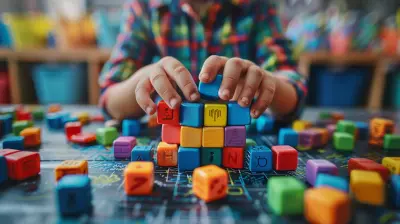Creating a Calm and Focused Learning Atmosphere
5 July 2025
Let’s be real — we live in a world that’s noisy, fast, and filled with distractions. Notifications, deadlines, social media, and a million tabs open in your brain (and probably on your browser too). So when it comes to learning — whether you’re a student, a teacher, or a self-learner — how in the world do you create a space that actually helps you concentrate?
That’s exactly what we’re diving into today: Creating a Calm and Focused Learning Atmosphere.
Because without calm, there’s no focus. And without focus, learning becomes a frustrating uphill battle instead of something meaningful and empowering.
Let’s roll up our sleeves and get into it — no fluff, no theory-heavy textbook stuff — just real, practical strategies that work.
Why Calm and Focus Go Hand-in-Hand in Learning
Picture this: You’re trying to study, and the neighbor’s dog won’t stop barking, your phone keeps lighting up with notifications, and your brain is going a mile a minute.Now, compare that to sitting in a quiet room, comfy chair, soft lighting, and zero distractions.
Which one sounds more productive?
Exactly.
Calmness is the foundation of focus. When your mind isn’t racing, it’s ready to absorb, process, and retain information. It’s like trying to fill a glass with water — you can’t do it if it’s already overflowing.
Creating a peaceful learning space gives your brain the breathing room it needs to actually think.
What Really Disrupts Calm in Learning Environments?
Before we get into building that zen zone, let’s call out the culprits. Here’s what typically wrecks a calm atmosphere:- Noise and interruptions – Whether it’s traffic, talkative family, or a buzzing phone, noise crushes focus.
- Cluttered or chaotic space – Messy room = messy head.
- Poor lighting and uncomfortable settings – You can’t learn while squinting or shifting in a rigid chair.
- Mental overload and stress – Too much to do? You’re not learning; you’re surviving.
- Multitasking – Spoiler: It doesn’t work. Your brain isn’t wired to juggle ten things at once.
Identifying distractions is step one. Kicking them to the curb? That’s step two.
How to Create a Calm and Focused Learning Atmosphere
Here comes the good stuff.We’re not just going to clean your desk and light a candle. We’re reshaping the entire learning vibe. Ready? Let’s go.
1. Design Your Physical Learning Space with Intention
Think of your study space like a mood – it should feel like “learning mode” the second you walk in.- Pick a dedicated spot – No more half-studying in bed or on the couch while the TV plays in the background. Choose 1 spot and make it sacred.
- Declutter – Out with junk, in with calm. A clear desk helps create a clear mind.
- Lighting matters – Natural light is gold. If that’s not possible, grab a warm, soft desk lamp. Harsh fluorescent bulbs? They’ve got to go.
- Comfort counts – Get a good chair. Add a cushion. You’re not hosting a party; you're building a learning sanctuary.
It doesn’t need to be Pinterest-perfect — it needs to feel right to you.
2. Eliminate Noise Like a Ninja
Silence might be golden, but let’s be honest — it’s not always available.- Use noise-canceling headphones – These are game changers. Pair them with focus music (think lo-fi, classical, or ambient sounds).
- Try white noise or nature sounds – Rainfall, ocean waves, or coffee shop chatter can hide annoying outside noise.
- Set boundaries – If you share your space, communicate your “do not disturb” hours. Don’t be afraid to be firm.
Your ears play a huge role in your brain’s ability to focus. What they hear matters more than you think.
3. Build a Brain-Friendly Routine
Consistency creates calm. When your brain knows what to expect, it doesn’t freak out.- Study at the same time daily – Your brain is like a pet; it loves routine.
- Start with the same activities – Light a candle, stretch, review notes — whatever puts you into "focus mode."
- Limit your sessions – Nobody’s focused for 3 hours straight. Try 25-minute sprints (Pomodoro technique), then take short breaks.
This rhythm tells your brain, “Hey, it’s learning time,” and it automatically begins to tune out distractions.
4. Kick Tech Distractions to the Curb
Yes, your phone is probably smarter than you. But it’s also your biggest enemy when learning.- Use focus apps – Tools like Forest, Focus Keeper, or Cold Turkey block distractions and reward you for staying on task.
- Put your phone in another room – Out of sight = out of mind.
- Turn off notifications – All of them. Ding-free is the way to be.
If you must use devices, turn them into allies, not enemies.
5. Bring in Brain-Boosting Elements
What if your space could actually feed your focus?- Plants – Yes, seriously. A little greenery boosts mood and reduces stress.
- Scents – Peppermint, lavender, or lemon oils can promote clarity. Just don’t go overboard.
- Color psychology – Blue tones = calm. Greens = balanced. Avoid harsh reds or flashy colors.
Your environment doesn’t just host your learning — it influences it in sneaky ways.
6. Fuel Your Mind for Focus
This isn’t a food blog, but let’s face it — you’re not focusing if you’re hungry, dehydrated, or running on sugar.- Water first – Dehydration = brain fog. Keep a water bottle close.
- Smart snacks – Nuts, fruits, dark chocolate. No sugar crashes or greasy fingers on the keyboard.
- Limit caffeine – One cup = alert. Three cups = jittery and panicking about tomorrow’s test.
Treat your brain like a VIP guest — it needs proper fuel.
7. Master the Mental Game
Let’s talk mindset. Because sometimes the loudest chaos isn’t outside you — it’s in your own head.- Practice mindfulness – Even 5 minutes of breathing or meditation can reset your brain.
- Positive self-talk – Tell yourself “I’ve got this” instead of “I’m so behind.”
- Break the big stuff down – Overwhelm kills focus. Chop big tasks into tiny, doable bites.
- Celebrate small wins – Finished a chapter? High-five yourself. Boom.
Your mind can be your biggest weapon or your worst enemy. Train it to stay calm, and focus follows naturally.
For Students: Quick Wins to Boost Calm in the Classroom
Whether you’re in high school, college, or studying remotely, here’s how to take control of your learning vibe even if you don’t control the space.- Keep your space tidy – Even a small desk can be a calm zone.
- Use digital tools wisely – Google Keep, Notion, Evernote — perfect for organizing chaos.
- Create a calming pre-study ritual – Journal, meditate, or just take five deep breaths.
And remember: You’re not lazy; you might just be overwhelmed. Get the calm back, and your motivation will start showing up again.
For Educators: How to Encourage a Calm Learning Environment
If you’re a teacher or mentor, you’ve got the power to set the mood.- Start class with a moment of calm – It’s like stretching before a run. Try breathing exercises or quiet reflection.
- Design your classroom intentionally – Calming colors, natural light, clean layout. It all adds up.
- Model calm behavior – If you’re frantic, your students will be too.
- Reduce unnecessary clutter or chaos – Over-decorated walls = overstimulated minds.
A calm classroom isn’t silent — it’s focused, respectful, and balanced.
Final Thoughts: It’s All About Creating Space to Think
At the end of the day, creating a calm and focused learning atmosphere isn’t about perfection. It’s not about expensive tools or designing a studio-style study cave.It’s about creating space. Mental space. Emotional space. Physical space. The kind that lets your brain do what it does best: focus, process, learn, and grow.
So whether you’re a student trying to pass finals, a teacher trying to create magic in your classroom, or a lifelong learner just trying to soak up some knowledge without losing your mind…
Remember: calm isn’t a luxury — it’s the foundation. Build from there, and everything else gets easier.
You’ve got this.
all images in this post were generated using AI tools
Category:
Classroom ManagementAuthor:

Bethany Hudson
Discussion
rate this article
1 comments
Wren Love
This article offers valuable insights on fostering a serene learning environment. Simple strategies like reducing noise, incorporating natural elements, and encouraging mindfulness can significantly enhance student focus and overall well-being.
July 22, 2025 at 3:02 AM

Bethany Hudson
Thank you for your thoughtful comment! I'm glad you found the strategies helpful for enhancing student focus and well-being.


